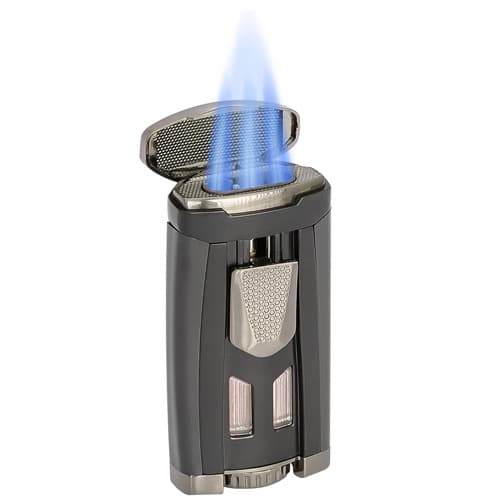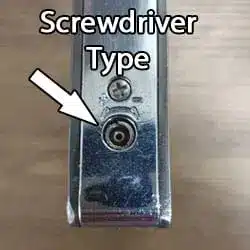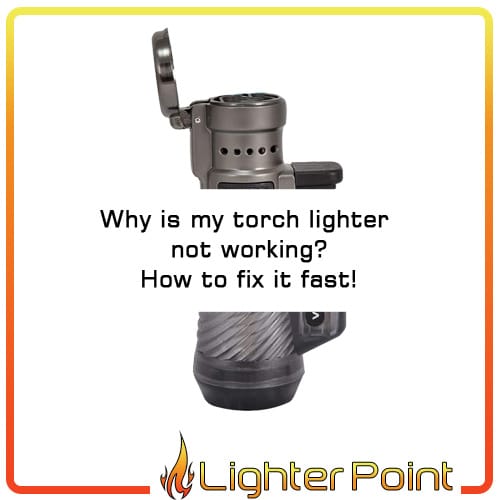There was a time I would get so frustrated with my torch lighter when it wouldn’t fire up or wasn’t working properly. I would get so upset watching my lighter hiss and sputter or not even light at all. Most of the time, I would either throw them away or put them in a desk drawer. Many of them were never to be used again. Over the years, I have learned a few valuable lessons, and now I can quickly troubleshoot most problems. Fixing them only takes a couple of minutes now. The reason for this post is so you can fix these little problems, too. All it takes is just a little bit of learning.

Shop Torch Lighters on Amazon
Why Your Torch Lighter Isn’t Working
Torch lighters are a cigar smoker’s best friend, delivering windproof jet flames (1,000-2,500°F). But when they fail, these common issues are usually to blame:
- No Gas or Low Gas Level: An empty tank stops ignition.
- Gas Adjustment Too High or Low: Incorrect fuel settings cause a weak flame, or too much fuel is blasting out, and it won’t ignite on the spark.
- No Spark: A faulty piezo igniter kills the flame from being ignited..
- Clogged Burners: Debris or low-quality butane blocks jets.
- Air Trapped in Fuel Lines: Air pockets from refilling cause sputtering.
These problems are common with basically all torch lighters, but are easy to fix with the right know-how. For fuel tips, check our best butane fuel for torch lighters guide.
Step 1: Does Your Torch Lighter Have Fuel?
The first question I ask when a cigar smoker’s torch lighter isn’t working is, “Is there fuel in it?” A low level or no butane is the most common issue I’ve found from stopping your lighter from igniting..
Ninety percent of the time, I get a frustrated, “Of course it’s got fuel!” But ten percent admit, “Uh, I’m not sure.” So, let’s check: does your torch lighter have fuel right now?
- If Yes: It’s fueled but still not working, move to Step 2 for more troubleshooting.
- If No: Purge your lighter to remove air and refill with high-purity butane (see our full guide on How to Bleed a Butane Lighter, or scroll down below the quick version).
- Not Sure?: Keep reading—we’ll guide you through checking and fixing it.
Shop High-Purity Butane on Amazon
Check Your Instruction Manual
Got the instruction manual that came with your torch lighter? If so, dig it out—it might list model-specific troubleshooting steps for brands like Colibri or Visol.
No manual? No stress! Most torch lighters (e.g., Xikar, S.T. Dupont) share similar mechanics for cigar use. Our fixes below work for nearly all models, getting your lighter to fire up again in no time. For brand-specific tips, see our best torch lighter brand guide.
Step 2: DOES YOUR LIGHTER HISS AND OR FLASH YOU DEPRESS THE TRIGGER
A torch lighter that is hissing, from the top when you press the trigger, means fuel is flowing in the right direction. If your torch hisses without pressing the trigger, you likely have an internal leak or busted seal, which is trickier to fix. Because there are so many different lighter companies and torch lighter models out there, it would be impossible to help you in this post. Let’s focus on the hiss or flash when you hit the trigger.
Best Single Jet Flame Torch Lighters
Just Hissing? A loud hiss suggests the flame setting is too high, a common issue for cigar lighters. Use a screwdriver to lower the flame adjuster (usually on the bottom) and test again.
If you hear a faint hiss or nothing, the flame setting may be too low, or you’re out of fuel. Turn the adjuster up slightly and test. No hiss after adjusting? You likely have a clog or no fuel—check Step 1 for fuel or Step 3 for clogs.


Shop Precision Screwdriver Kits on Amazon.
Step 3: ARE YOU GETTING A SPARK ON YOUR TORCH LIGHTER?
After adjusting your flame setting up or down, are you still just getting a hiss, or are you getting a flash of fire and a hiss?
If adjusting the flame didn’t fix your not working torch lighter, check for a spark when you press the trigger. A hiss with no flame or a brief flash suggests spark issues, or you may need to keep working flame adjustment.
- No Spark? A dead piezo igniter is the worst case, but more often, the igniter tip is dirty from cigar ash or debris. Use compressed air (e.g., Dust-Off) to blow short bursts over the igniter tip, or gently clean with a cotton swab and isopropyl alcohol. Test for a spark—keep your face clear to avoid burns if it ignites!
- Hiss or Flash with Spark? You’re on the right track! A strong spark with a hiss or fleeting flame means fuel is flowing but may be blocked by clogs (see Step 4) or air pockets (see our how to bleed a butane lighter guide).

Check to see if you have a spark. Be careful when checking for a spark. DO NOT put your face close to the lighter, or you could be burned if it fires up. If you have a good spark and hear a hiss or have a flash and hiss, you’re moving in the right direction.
For more troubleshooting, check our why does my torch lighter sputter guide to keep your lighter firing for cigar sessions.
Step 4 DOES YOUR LIGHTER FLASH OR QUICKLY FLAME OUT?
When you have a torch lighter not working correctly and hit the trigger, do you get a quick flash or does it ignite only to burn out quickly?
If you get a quick flash and continue to hear hissing and/or have a weak-looking flame grab a can of compressed air. Use the compressed air to clean out the burner or burners of your non-working torch.
Impurities from cheap butane as well as pocket lint as well as other things can clog up your burners causing problems for your lighter. Always use high-quality butane for your lighter.

See our guides on
Does Butane Quality Matter
and
Best Butane Fuel For Torch Lighters
Step 5 IS YOUR TORCH LIGHTER PURGED/BLED?
Lastly, have you purged your lighter to get rid of all the air in the system?
If you didn’t purge or bleed your lighter before filling it with butane can cause your cigar lighter to flash and hiss. Not purging lighters is probably the second common issue that I see with a torch lighter that’s not working correctly.
Before purging your lighter, make sure there is no lit flame or any kind of fire around you. Also, extinguish anything like cigars or cigarettes because butane is incredibly flammable.
First, make sure your eyes are protected. Use safety glasses or goggles. Next, lay out a rag on a desk or table. Hold the lighter vertically and use a purging tool or small screwdriver to depress the fill stem at the bottom of your lighter.
Use caution here! When you depress the fill stem, there will be a blast of propellant and butane that comes out quickly from the bottom of the lighter. You might have to do this several times until no more air, butane, or propellant comes out. See the complete bleeding guide here.
Best Quad Flame Torch Lighters
HOW TO REFILL A BUTANE LIGHTER – Torch Lighter Not Working Part 2
Before you purge or try to fill a butane lighter, you need to make sure it is cooled off. You don’t need to put it in the freezer or anything, but wait about five minutes.
Fuel Flow Adjustment
Before you refill your lighter, turn the flame adjustment all the way down.
Most lighters have arrows pointing to + / – for flame height. If your lighter doesn’t have these arrows, turn the adjustment clockwise.
Purge the lighter.
Not that your flame adjuster is all the way down. Let’s purge all the air from the lighter.
Many people make the mistake of trying to fill a butane lighter with purging. As I mentioned above, purging means nothing more than getting all the air and any leftover propellant from your lighter.
When purging, ALWAYS keep the fill/purge valve away from your face!
Flip your lighter so the fill/purge valve is facing up. Again, the valve is usually bottom.
Press the purge/fill stem with your screwdriver or lighter key. The air and propellant is going to blast out of the valve stem. Again, always keep the valve away from your face.
You’ll know your lighter is completely empty when you can depress the valve without hearing any more air come out.
Fill your lighter with butane
Flip your butane can so the stem is pointing down.
Make sure your lighter’s fill valve is pointing up.
Firmly push the butane nozzle down over the fill valve of your lighter. You only need to press down for 5 to 10 seconds. Typically, you’ll hear some hissing coming from the can as it fills.
Before You Fire Up Your Torch Lighter
Wait for 3 to 5 minutes before lighting up your torch after you fill a butane lighter.
You may have to make some adjustments to the fuel flow/flame adjuster to get the flame the size you want.
The Conclusion of a Torch Lighter Not Working Correctly
After cleaning out your burners and igniter with compressed air and purging your lighter, you should be good to go. If you’re still having problems with your torch lighter not working correctly, you may need to contact the seller or manufacturer for help.
Every time I fill any of my torch lighters, I make sure they are completely purged before filling with butane. As a general rule for maintenance, I also used canned air to clean out burners and the igniter when I fill lighters.
To make sure you avoid a torch lighter not working correctly, just follow these simple maintenance steps.
Torch Lighter Not Working FAQs
Why does my torch lighter hiss but not light?
A hissing torch lighter without a flame often points to a clogged burner or low spark, common when toasting 48-60 ring gauge cigars. Clean the jets with compressed air to remove ash or butane impurities, and check the piezo igniter for debris to ensure a steady flame for your cigar sessions.
Can low-quality butane cause my torch lighter to stop working?
Yes, low-quality butane (less than triple-refined) leaves impurities that clog jets, causing your cigar lighter to sputter or fail. Use 5x+ refined butane to prevent flavor taint in 42-50 ring gauge cigars and maintain windproof performance for outdoor smoking. See our guide on Butane Quality
How do I know if my torch lighter’s flame adjustment is wrong?
If your torch lighter produces a weak or unstable flame when lighting cigars, the flame adjustment may be too high or low. Adjust the wheel (usually on the bottom) to a medium setting for a steady blue flame (~1-2 inches), ideal for even toasting of 48-60 ring gauge cigars.
Why does my torch lighter work inconsistently for cigars?
Inconsistent performance, like sporadic flames or misfires, often stems from air pockets or dirty igniters in lighters like Xikar or Vertigo. Bleed the tank before refilling and clean the igniter with a cotton swab to ensure reliable toasting for premium cigars. We have a guide on sputtering torch lighters that may help.
Can I fix a torch lighter that leaks butane?
A leaking torch lighter, noticeable by hissing when not triggered, likely has a damaged valve or seal, posing a safety risk for cigar smoking. Contact the manufacturer for repairs, as this issue is complex. You may want to consider replacing your lighter. Check out our picks for Most Reliable Torch Lighters
Why is my torch lighter not working after refilling?
Air pockets or low-quality butane often cause sputtering after refilling, disrupting your 42-60 ring gauge cigar toasting. Bleed the tank to remove air and use 5x+ refined butane for a steady flame, ensuring clean burns for premium cigars.
How often should I clean my torch lighter for cigar smoking?
Clean your torch lighter monthly to prevent clogs from ash or low-quality butane, ensuring flawless toasting for 48-60 ring gauge cigars. Use compressed air to clear jet nozzles and maintain windproof performance for lounge or patio sessions.
Why does my torch lighter spark but not light?
A spark without a flame often means clogged nozzles or air pockets, common in Xikar or Colibri lighters used for cigars. Clean the jets with compressed air and bleed the tank to restore a steady flame.
Should I replace my torch lighter if it keeps failing?
If cleaning and bleeding don’t fix chronic issues like worn valves or seals, replace your lighter with a reliable model. See our picks for the Most Reliable Torch Lighters
One Last Thing
It is always best to use highly refined butane for filling torch lighters. We recommend using quality brands like XIkar Purofane or Colibri Butane. We also put together a post on how to find the best butane for torch lighters that also has our top 5 brands.
I genuinely hope this quick troubleshooting guide helps if you have a torch lighter not working perfectly for you.
As always, if you have comments or questions, click here to use the contact page to get a hold of us or drop a comment down below.

